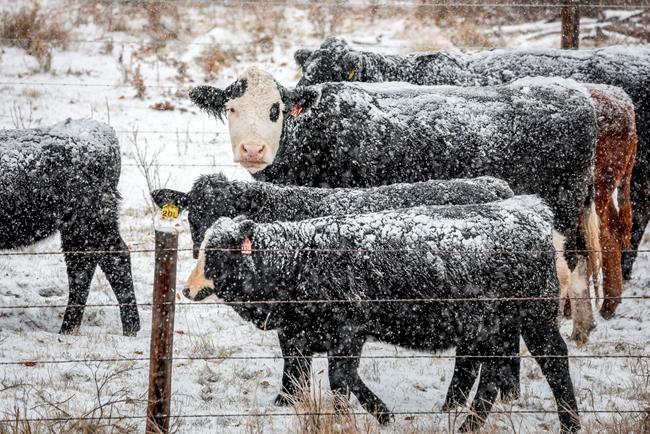CALGARY — It could be a long, lean winter in cattle country as drought-ravaged western Canadian ranchers struggle to secure feed to get their livestock through the cold months.
Near the town of Eastend in the southwest corner of Saskatchewan, Jocelyn Wasko and her husband Travis have spent much of the summer and fall preparing. They've worked hard to grow their own forage crops, even taking a few thousand acres of durum wheat that didn't grow well enough to sell and cutting and baling it for feed instead.
Still, after five consecutive years of very little rain on the property that Travis' family has been ranching for more than a century, the parched land can only produce so much. That's why the couple made the tough decision last year to downsize their herd, culling close to 20 per cent of their cows by sending them to slaughter at weaning time.
"We really had no option when we finished out the year last year — all the dugouts were empty and there was no grass," Wasko said in a recent interview.
"And it's really expensive to truck feed into this area. The freight is just killing us."
Across large swathes of the country, extreme heat and dry conditions have taken a toll on agricultural production this year.
As of Sept. 30, according to Agriculture sa╣·╝╩┤½├Į's most recent update, 72 per cent of the country and 69 per cent of sa╣·╝╩┤½├Į's agricultural landscape was considered either "abnormally dry" or in "moderate to exceptional drought."
But drought's effects aren't felt only in the summer. For cattle producers, winter is when the toll can be most severe, as animals' caloric needs are higher and grazing land is frozen or snow-covered.
"Certainly, the impacts are carrying on for people that utilize the resources that were depleted during the summer," said Trevor Hadwen, a Regina-based agroclimate specialist with Agriculture sa╣·╝╩┤½├Į.
"It's resulted in poor forage and water supply issues for the livestock industry."
From northern sa╣·╝╩┤½├Į to central Ontario, farmers have had to cope with dry conditions this year. But southern Alberta and southwest Saskatchewan in particular have been what Hadwen calls "hot spots."
In these regions — home to the bulk of sa╣·╝╩┤½├Į's cattle production — the problem isn't this year's drought alone, but the fact that ranchers have now faced years of back-to-back cumulative droughts.
In fact, Hadwen said there are some areas that have officially been in drought for more than 30 of the last 36 months. As a result, locally grown livestock feed is in short supply and imported feed costs have gone through the roof.
At the same time, the amount of moisture in the soil continues to dwindle each year, and many of the reservoirs and rivers are running extremely low.
Sheila Hillmer, who ranches south of Lethbridge, Alta., near the U.S. border, said "ridiculous high temperatures" this summer meant the grass in her pastures basically stopped growing in June. And while her land does have some irrigation infrastructure, the taps had to be shut off mid-July due to concerns over water shortages.
"It's just been a real challenge, you know, to try to keep cattle through this," she said,adding she believes many ranches only stay afloat because their owners supplement their operations by taking an off-farm job.
"We're blessed because our kids are the fourth generation on our place, and we've always hoped we'll see five or six more to come," Hillmer added.
"But that's going to depend on our ability to survive."
Because many producers over the past several years have had to cull their herds or exit the industry entirely, there are simply less cattle on Canadian ranches in 2023 and less beef being produced.
According to Farm Credit sa╣·╝╩┤½├Į, year-to-date Canadian beef production in 2023 is down six per cent compared to last year. The supply shortage has driven up cattle prices, which are forecasted to average a whopping 33 per cent higher year-over-year in 2023 and 50 per cent higher than the five-year average.
Brodie Haugan, chair of the Alberta Beef Producers organization, said the industry could be about to enter a sustained period of higher prices and strong profitability. But he said that's only a benefit for those ranchers who have still been able to keep their heads above water.
Haugan said he was pleased to see the federal and Alberta governments announce last week they will partner on a $165 million drought livestock relief program for this yearto help get producers through this winter.
But he added ranchers need longer-term supports to shield their operations against future droughts.
"We're hoping to have an honest conversation around what a true risk mitigation program, that actually supports the cattle industry in a timely and confident manner, looks like," he said.
"Let's hope we can get it implemented for next year so that it builds that confidence back into our industry. Because we're going to see this again. We're going to have bad years again."
This report by The Canadian Press was first published Oct. 27, 2023.
Amanda Stephenson, The Canadian Press



